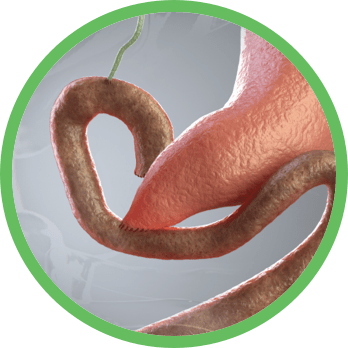The Pancreas
and EPI
Review the role of the pancreas in digestion
Examining the role of the pancreas in digestion can help clarify the etiology of Exocrine Pancreatic Insufficiency (EPI). EPI is caused by inadequate production, delivery, or activity of the pancreatic enzymes needed for digestion.1
The pancreas has 2 roles within the body
85% exocrine (acinar and duct tissue)2-4:
- Acinar cells synthesize, store, and secrete digestive enzymes such as lipase, protease, and amylase into the duodenum
- Ductal cells secrete NaHCO3 and water, which neutralizes the acidic pH of food, and helps carry the digestive enzymes into the duodenum
2% endocrine (islets of Langerhans)2:
- The islets of Langerhans release pancreatic hormones such as glucagon, insulin, somatostatin, and pancreatic polypeptide
- These hormones are secreted directly into the bloodstream and help control glucose levels
Pancreatic exocrine and endocrine tissue are closely linked both anatomically and physiologically.5 Conditions that affect one tissue type can cause an impairment in the other.6,7
The pancreatic digestive enzymes
The major hormonal stimulus that causes pancreatic digestive enzyme secretion is the release of cholecystokinin (CCK) from the duodenum.8-10
The pancreatic enzymes are comprised of9:
- Lipase – breaks down fats into fatty acids
- Protease – breaks down proteins into amino acids
- Amylase – breaks down carbohydrates into simple sugars
Bicarbonate alkalinizes intraluminal duodenal pH and prevents inactivation of the enzymes.8,9
When nutrients arrive in the proximal small bowel, the pancreatic enzymes begin to break them down.9
Digestion and absorption of nutrients is dependent on normal pancreatic enzyme secretion and function8
Normal pancreatic enzyme secretion11(lipase units per meal)
480K
720K(average)
960K
Normal pancreatic enzyme secretion varies with content and volume of meal ingested. Normal digestion also depends on postprandial synchrony between delivery of nutrients to the duodenum and discharge of pancreatic enzymes.11
EPI is caused by inadequate production, delivery, or activity of pancreatic enzymes needed for normal digestion1

EPI may result in:
Maldigestion12
EPI leads to an inability to digest food properly, with fat maldigestion being the most profound.
Malabsorption12
Malabsorption of fat-soluble vitamins A, D, E, and K may accompany EPI.
Malnutrition13,14
EPI-related maldigestion and malabsorption can lead to malnutrition and weight loss.
Gastrointestinal symptoms9,13,15,16
EPI can lead to GI symptoms due to undigested and unabsorbed food. Steatorrhea, the most common clinical manifestation of EPI, may not occur until the disease is advanced. Yet, there may be significant maldigestion and malabsorption without overt steatorrhea.
References: 1. Lindkvist B. Diagnosis and treatment of pancreatic exocrine insufficiency. World J Gastroenterol. 2013;19(42):7258-7266. 2. Röder PV, Wu B, Liu Y, Han W. Pancreatic regulation of glucose homeostasis. Exp Mol Med. 2016;48:e219. doi:10.1038/emm.2016.6 3. Gorelick FS, Jamieson JD. Structure-function relations in the pancreatic acinar cell. In: Johnson LR, Barrett KE, Ghishan FK, Merchant JL, Said HM, Wood JD, eds. Physiology of the Gastrointestinal Tract. 4th ed. Burlington, MA: Elsevier Academic Press; 2006:1313-1335. 4. Pandol SJ. The exocrine pancreas. In: Granger DN, Granger JP, eds. Colloquium Series on Integrated Systems Physiology: From Molecule to Function to Disease. San Rafael, CA: Morgan & Claypool; 2011:1-64. 5. Shiratori K, Shimizu K. Insulo-acinar relationship. In: Beger HG, Warshaw AL, Büchler MW, et al, eds. The Pancreas: An Integrated Textbook of Basic Science, Medicine, and Surgery. 2nd ed. Oxford, UK: Blackwell Publishing Limited; 2008:136-142. 6. Ewald N, Kaufmann C, Raspe A, Kloer HU, Bretzel RG, Hardt PD. Prevalence of diabetes mellitus secondary to pancreatic diseases (type 3c). Diabetes Metab Res Rev. 2012;28(4):338-342. 7. Cui Y, Andersen DK. Pancreatogenic diabetes: special considerations for management. Pancreatology. 2011;11(3):279-294. 8. Fieker A, Philpott J, Armand M. Enzyme replacement therapy for pancreatic insufficiency: present and future. Clin Exp Gastroenterol. 2011;4:55-73. 9. Alkaade S, Vareedayah AA. A primer on exocrine pancreatic insufficiency, fat malabsorption, and fatty acid abnormalities. Am J Manag Care. 2017;23(12)(suppl):S203-S209. 10. Chandra R, Liddle RA. Neural and hormonal regulation of pancreatic secretion. Curr Opin Gastroenterol. 2009;25(5):441-446. 11. Keller J, Layer P. Human pancreatic exocrine response to nutrients in health and disease. Gut. 2005;54(suppl 6):vi1-vi28. 12. Ferrone M, Raimondo M, Scolapio JS. Pancreatic enzyme pharmacotherapy. Pharmacotherapy. 2007;27(6):910-920. 13. Domínguez-Muñoz JE. Pancreatic enzyme therapy for pancreatic exocrine insufficiency. Curr Gastroenterol Rep. 2007;9(2):116-122. 14. Lindkvist B, Phillips ME, Domínguez-Muñoz JE. Clinical, anthropometric and laboratory nutritional markers of pancreatic exocrine insufficiency: prevalence and diagnostic use. Pancreatology. 2015;15(6):589-597. 15. Dumasy V, Delhaye M, Cotton F, Deviere J. Fat malabsorption screening in chronic pancreatitis. Am J Gastroenterol. 2004;99(7):1350-1354. 16. Smith RC, Smith SF, Wilson J, et al; Working Party of the Australasian Pancreatic Club. Summary and recommendations from the Australasian guidelines for the management of pancreatic exocrine insufficiency. Pancreatology. 2016;16(2):164-180.
